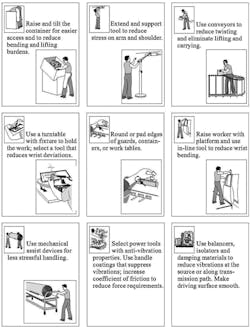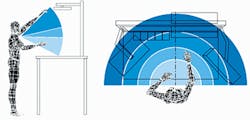Four Simple Ergonomic Steps to a More Productive Workplace
Workplace ergonomics is getting a lot of attention nationwide in response to a sharp increase in musculoskeletal disorders such as carpal tunnel syndrome. These occupational injuries often mean repeated surgery, intractable pain, inability to work, time off for the affected employee and ultimately, higher costs for the employer.
Factors such as work surfaces at the wrong height, uncomfortable chairs, shelves and bins that are too high or out of reach and awkward hand tools all contribute to increased risk of musculoskeletal injuries and negatively can impact productivity.
See Also: Environmental and Workplace Health Regulations & Standards
Paying attention to ergonomics means removing barriers to work productivity. There is a wealth of options available to adjust the workspace to meet employees' ergonomic needs, and selecting the right options can help employees reap significant bottom line rewards. Comfortable employees stay at their desks or workstations longer, and complete more work in a given shift. Employers who pay attention to these four simple steps are well on their way to gaining these rewards.
By adapting tasks, workstations, tools and equipment to fit the worker, ergonomics seeks to reduce physical stress on a worker's body and eliminate many potentially serious, disabling work-related musculoskeletal disorders (MSDs). If work tasks and equipment do not include ergonomic principles in their design, workers may experience physical stress, strain and overexertion, including exposure to vibration, awkward postures, forceful exertions, repetitive motion and heavy lifting.
Step 1 - Review Tasks for Risk Factors
The first step to correcting problems is to understand the key workplace ergonomic risk factors and review work tasks in your operation to see which ones apply. This can make a tremendous difference, since occupational safety professionals estimate that reducing physical stresses could eliminate as many as half the serious injuries that happen each year.
Predicting what might go wrong and modifying tools and the work environment to make tasks safer for workers is the first step to reducing problems. The key risk factors and the injuries that can occur include the following: (Figure 1 illustrates a few of these factors):
• Force – Exerting excessive force can cause a variety of injuries.
• Repetition – Excessive repetition of movements can irritate tendons and increase pressure on nerves.
• Awkward postures – Positions that stretch physical limits can compress nerves and irritate tendons.
• Static postures – Positions that a worker must hold for long periods of time can restrict blood flow and damage muscles.
• Quick motions – Increased speed or acceleration when bending and twisting can increase the amount of force exerted on the body.
• Compression or contact stress – Grasping sharp edges like tool handles can concentrate force on small areas of the body, reduce blood flow and nerve transmission and damage tendons and tendon sheaths.
• Recovery time – Inadequate recovery time due to overtime, lack of breaks and failure to vary tasks can leave insufficient time for tissue repair.
• Vibration – Excessive vibration from tools can decrease blood flow, damage nerves and contribute to muscle fatigue. Whole body vibration can affect skeletal muscles and cause low-back pain.
• Cold temperatures – Working in cold temperatures can adversely affect a worker's coordination and manual dexterity and cause a worker to use more force than necessary to perform a task.
Step 2 - Control Risk Factors
Engineering controls, administrative controls and personal protective equipment (PPE) are the three key ways to control the risks identified earlier. Examine each of these optionsto see how each may be used to control risks.
Engineering controls to improve ergonomic risks may include changing the way parts and materials are transported; changing the process to reduce how workers are exposed to risk factors; moving parts around to make it easier for workers to reach them; or changing work station layout, tool design or access and assembly sequence.
Of equal impact are administrative controls; adjusting work practices and policies to reduce risk factors. Examples include rest breaks, job rotation or training to identify signs of ergonomic stress.
Finally, PPE may be considered, including wrist supports, back belts or vibration attenuation gloves. However, it should be noted that although PPE may reduce the duration, frequency or intensity of exposure to risk, its effectiveness in injury reduction is considered inconclusive by NIOSH. Figure 2 is an illustration of the general ways of reducing the risk factors identified in Step 1.
Step 3 - Understand How to Make the Workspace Ergonomic
With any task, selecting the proper tool is crucial. The key is to understand the work process and employees' safety needs. After identifying the likely risk factors in an operation, develop a safer work environment by carefully selecting the tools and workstations workers will use. Start the process by asking these questions:
• Does the work process involve handling heavy, bulky or awkward products?
• Is there a high product mix, with many product changeovers per day?
• Will workstations be integrated with material flow – with racks or conveyors, for example?
• Is there frequent job rotation, with employees from different shifts or departments sharing a work area?
• Will employees work alone, back-to-back or in teams?
• Does a workstation need to include power tools, computer equipment, supplemental lighting or storage space?
Issues frequently encountered by employees include work surfaces that are the wrong size or at the wrong height, uncomfortable chairs, shelves and bins that are too high or out of reach and awkward hand tools.
To counter these issues, it is important that employees easily can rearrange workstation elements. Regardless of physical characteristics or the tasks performed, employees should be able to make adjustments to work surface height and chair seat height, or change the elevation of work shelves and work surfaces to increase worker comfort and productivity.
Step 4 - Use Workstation Design Principles to Improve Ergonomics
The most important principle to keep in mind is that work is handled most efficiently when kept within areas defined as "primary reach zones." These are the horizontal and vertical areas that a worker can reach with minimal arm, head or trunk movement. Moving away from these primary zones requires more movement and ultimately, more time.
Ergonomic solutions help keep most work tasks focused within these reach zones. Figure 3 illustrates this concept, with work taking place within a 24-inch radius; everything else should be considered storage. Figure 4 pictures workers within these horizontal and vertical work zones.
To minimize stress and strain for seated employees, the workstation should be at the proper height to support the particular task being performed. Precision work usually requires a higher work surface, while heavier work demands a lower work surface. Generally speaking, a 30.5-inch work surface height will accommodate 99.5 percent of all male and 99.9 percent of all female workers.
But what if different shifts are using the same bench or what if different tasks are being performed on the same bench? If so, consider an adjustable-height workstation. With such a bench, users can adjust the bench height with the simple turn of a crank or with a motor drive, and the work surface can move between approximately 27 and 38 inches. This would accommodate the height of the widest range of workers, from about 5 feet to 6 feet 8 inches.
Other considerations for a workstation include convenient reach and accessibility to accessories, like hand tools, small parts, nuts and bolts, a comfortable and adjustable chair, a foot rest and proper lighting.
A final consideration, and one that is becoming more and more important, is the location of computer monitors. It is important that monitors can be adjustable up or down to be at the employee's eye level. With the increased use of flat panel monitors, employers are finding swing arms a useful tool for properly positioning monitors to avoid strain. The use of a negative-tilt keyboard tray also is recommended for reducing wrist strain.
James Anderson is the vertical markets and national accounts manager for Stanley Workplace Solutions. He has over 25 years of experience in the industry and is an expert on ergonomic workspace solutions.




